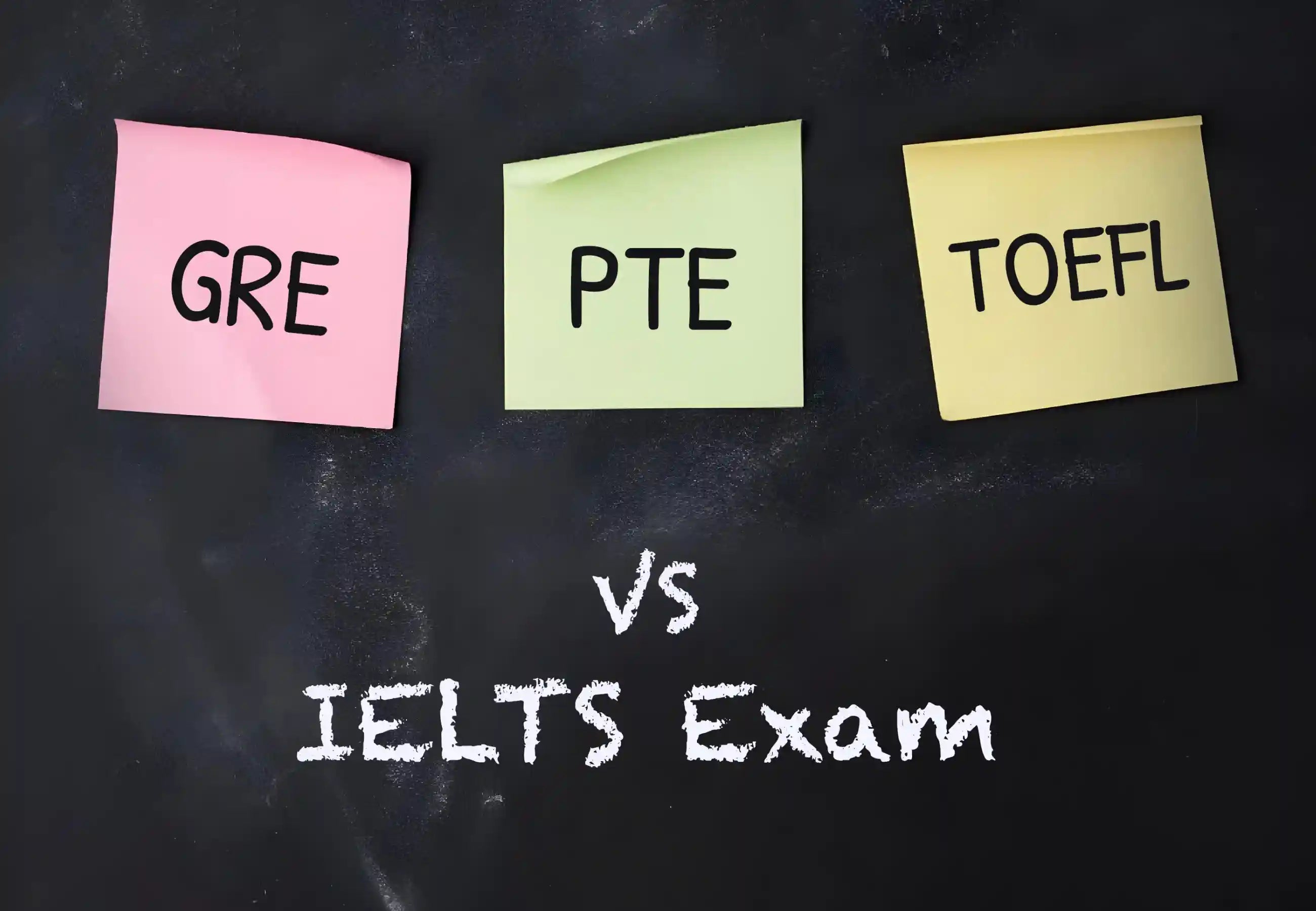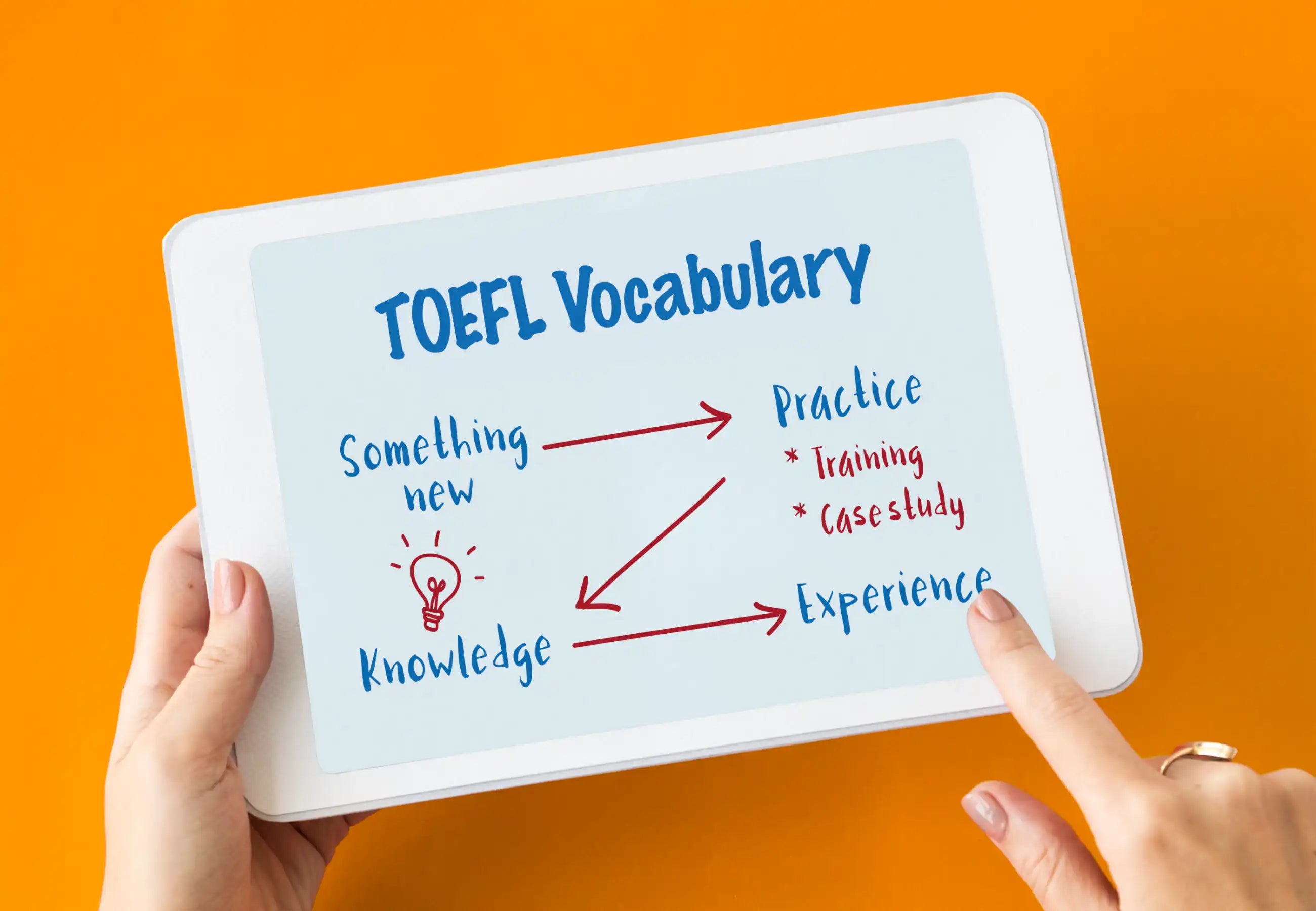The TOEFL (Test of English as a Foreign Language) exam is one of the most widely trusted English proficiency exams for students who wish to study abroad. It is accepted by over 12,000 universities and institutions in 160+ countries, including top destinations such as the USA, Canada, the UK, Europe, Australia, and Asia.
Most universities require proof of English proficiency for admission, scholarships, or even visa applications, and the TOEFL exam is often their first preference because of its accuracy, security, and academic-style testing.
TOEFL Exam Versions
ETS (the official test provider) offers three versions of the TOEFL exam, but not all versions are available in every country or accepted by every university. Understanding the differences is crucial because your Choice of test version affects the cost, availability, test day experience, and acceptance.
1. TOEFL iBT (Test Centre Version)
- Computer-based test taken at an official test centre
- Most widely used and trusted version of TOEFL
- Offered frequently (multiple dates every month)
- Measures all four skills: Reading, Listening, Speaking, Writing
- Fully accepted by almost all universities and visa offices worldwide
This is the primary and most recommended version.
2. TOEFL iBT Home Edition
- Same format, content, and scoring as test-centre iBT
- Taken from home using a computer, webcam, and the internet
- A live human proctor monitors the test remotely
- Convenient for students with no nearby test centre
- Accepted by most universities, but visa acceptance varies by country
This is a good option for flexible scheduling, but you must meet strict technical and environmental requirements.
3. TOEFL Paper Edition
- Available only in limited countries and test centres
- Reading, Listening, and Writing are taken at a test centre on paper
- Speaking is taken at home on a computer within 3 days after the test
- Same content as iBT, but less commonly offered
TOEFL Exam Pattern 2025 (Section-wise Structure & Duration)
The TOEFL iBT (Internet-Based Test) is the most widely accepted format. As of 2025, the TOEFL iBT has been redesigned to be shorter, more student-friendly, and more efficient, while still testing academic English skills.
Total Test Duration: 1 hour 56 minutes (approx.)
The test has 4 sections, taken in a fixed order:
|
Section |
Duration |
No. of Tasks |
|
Reading |
20 minutes |
2 passages |
|
Listening |
36 minutes |
3 lectures + 2 conversations |
|
Break |
10 minutes |
- |
|
Speaking |
16 minutes |
4 tasks |
|
Writing |
29 minutes |
2 tasks |
Total Time: 1 hour 56 minutes
1. Reading Section (20 minutes)
- 2 academic passages
- 10 questions per passage
- Question types: MCQs, vocabulary, sentence placement, summary
- Tests comprehension, vocabulary, inference, and overall understanding
2. Listening Section (36 minutes)
- 3 lectures (4–6 minutes each)
- 2 conversations (2–3 minutes each)
- 5–6 questions per lecture/conversation
- Test's ability to understand academic discussions, main ideas, tone, and details
3 Speaking Section (16 minutes)
- It includes 4 tasks, primarily aimed at clearing this Section. It tests fluency, clarity, coherence, pronunciation, and academic communication skills
- Independent speaking (express opinion)
- Integrated Read + Listen + Speak
- Integrated Listen + Speak
- Integrated Read + Speak
4. Writing Section (29 minutes)
It tests organisation, grammar, vocabulary, and the ability to combine information
- Integrated Writing (Read + Listen + Write) – 20 min, ~150–225 words
- Academic Discussion Task – 10 min, ~100+ words
Adaptive Changes and Updates
- Test made shorter (approx. 2 hours)
- Independent Writing replaced with Academic Discussion Task
- No unscored experimental questions
- More clear instructions and a user-friendly interface
- Enhanced fairness and scoring accuracy
Continue Reading: TOEFL Exam Pattern
TOEFL Syllabus 2025 (Skills + Question Types)
The TOEFL syllabus is skill-based, not topic-based. It assesses your ability to understand and use English effectively in academic contexts.
Below is a complete section-wise syllabus:
A) Reading Syllabus
Skills Tested:
- Vocabulary in context
- Main idea & purpose
- Inference and tone
- Paraphrasing
- Summary and details
Question Types:
- Multiple Choice (single/multiple answer)
- Insert sentence
- Complete summary
- Vocabulary meaning
- Reference questions
Passage Topics:
- Science
- History
- Social Science
- Arts & Culture
- Technology
B) Listening Syllabus
Skills Tested:
- Understanding main ideas
- Recognising organisation
- Listening for detail
- Speaker attitude/tone
- Cause-and-effect relationships
Question Types:
- MCQs
- Multiple answer
- Replay question
- Chart/table completion
Audio Types:
- University lectures
- Classroom discussions
- Student–professor conversations
- Campus conversations
C) Speaking Syllabus
Skills Tested:
- Spoken fluency
- Pronunciation & clarity
- Idea structure
- Summarising information
- Academic communication
Task Types:
- Independent opinion (1 task)
- Read + Listen + Speak (1 task)
- Listen + Speak (1 task)
- Read + Speak (1 task)
Each task is recorded and evaluated later.
D) Writing Syllabus
Skills Tested:
- Grammar & vocabulary
- Coherence & structure
- Idea development
- Ability to combine reading/listening information
Task Types:
- Integrated Writing (Read + Listen + Write)
- Academic Discussion Task (respond in chat format)
Weightage by Section
|
Section |
Skills |
Weightage (out of 120) |
|
Reading |
Comprehension |
30 |
|
Listening |
Understanding speech |
30 |
|
Speaking |
Communication |
30 |
|
Writing |
Written expression |
30 |
Total Score = 120
TOEFL Exam Fee in India
TOEFL iBT exam fee is around ₹17,000 – ₹18,500 (approximately)
This fee may vary slightly due to taxes, currency conversion, or ETS updates.
This fee includes:
- TOEFL test
- Sending scores to 4 universities for free
- Access to TOEFL test prep resources (basic)
TOEFL Exam Fee in Other Major Countries
|
Country |
TOEFL iBT Fee (Approx.) |
|
India |
₹17,000 – ₹18,500 |
|
USA |
$235 |
|
Canada |
$245 |
|
UK |
£185 – £195 |
|
Australia |
$300 AUD |
|
Germany / EU |
€230 – €240 |
|
China |
¥1,800 – ¥2,000 |
|
UAE / Middle East |
$240 – $250 |
Why fees vary:
ETS adjusts pricing based on local currency, taxes, and test centre operational costs.
Additional TOEFL Fees & Charges to Know
Many test-takers end up paying more due to extra services. Here is a full list:
1. Late Registration Fee
If you register after the regular deadline.
Amount: $40 (₹3,500 – ₹4,000)
2. Rescheduling Fee
If you change your test date or test centre, please notify us.
Amount: $60 (₹5,000 – ₹5,500)
You must reschedule at least 4 days in advance.
3. Cancellation & Refund Policy
Cancel ≥ 4 days before test: 50% refund
Cancel < 4 days: No refund
4. Additional Score Reports
You get 4 free score reports.
After that, each additional report costs:
$20 per university (₹1,700 – ₹2,000)
5. Score Review / Re-evaluation Fee
This is only available for the Speaking and Writing sections.
Per Section: $80 (₹6,500 – ₹7,000)
Both sections review: $160
6. Returned Payment Charge
If your payment fails or is reversed, please get in touch with us.
Fee: $20 (₹1,700)
7. TOEFL iBT Home Edition Fee
Same as test-centre version (₹17,000 – ₹18,500)
Some regions may add small processing charges.
8. TOEFL Paper Edition Fee
Typically, it's the same as iBT or slightly cheaper, but it's offered in limited countries and centres only.
Looking for TOEFL cost-saving tips? Our guide on how to buy TOEFL voucher is a great resource.
TOEFL Exam Fees 2025 – Complete Cost Breakdown
|
Fee Type |
Amount |
|
TOEFL iBT Test Fee (India) |
₹17,000 – ₹18,500 |
|
TOEFL iBT Test Fee (Global) |
$235 – $260 |
|
Late Registration Fee |
$40 |
|
Rescheduling Fee |
$60 |
|
Cancellation Refund |
50% (if ≥ 4 days before) |
|
Additional Score Report |
$20 each |
|
Score Review (Speaking/Writing) |
$80 peSectionon |
|
Returned Payment Fee |
$20 |
|
Home Edition Fee |
Same as iBT |
|
Paper Edition Fee |
Like iBT (limited availability) |
How to Save Money on TOEFL Exam Fees
1. Book early to avoid late fees
Register 2–3 weeks in advance to avoid the $40 late charge.
2. Prepare well to avoid retakes
Every retake = full fee again. A good study plan can save ₹17,000–₹18,000.
3. Use the 4 free score reports wisely
Create a university list to avoid the $20 charge per extra report.
4. Avoid rescheduling
Changing your date costs $60. Book only when confident.
5. Use discounted vouchers (if available in your region)
Authorised platforms occasionally provide discounted TOEFL vouchers or bundled offers.
6. Choose TOEFL Home Edition if travel costs are high
The home edition has the same fee but helps you save on transportation and accommodation.
TOEFL Exam Dates 2025
The TOEFL exam is not held on fixed national dates like entrance exams. Instead, it follows a rolling schedule, meaning test dates are available year-round and vary by test centre.
To help you plan better, here is a detailed explanation of how TOEFL dates work and when you should book.
A) How TOEFL Releases Test Dates
- ETS updates dates continuously based on demand.
- New dates are added months in advance.
- Students can view and book dates directly on the ETS website.
- Availability depends on the city and the test centre capacity.
- You can take the test multiple times a month, provided slots are available.
B) High-Demand vs Low-Demand Months
|
Time Period |
Demand Level |
Why |
|
Jan – Mar |
High |
Students preparing early for the Fall intake |
|
Apr – Jun |
Medium |
Good for early prep, fewer applicants |
|
Jul – Aug |
Very High (Peak) |
Final attempts before Fall deadlines |
|
Sep – Oct |
High |
Last chance for Fall or early Spring intake |
|
Nov – Dec |
Medium |
Good for Spring or an early start for the next cycle |
Insight: Jul–Oct is the most competitive period. Slots fill up quickly, especially in metro cities.
C) Sample Month-wise Availability Overview
|
Month |
Availability |
Best For |
|
January |
Many slots |
Early Fall planners |
|
February |
Many slots |
Retakes or strong prep |
|
March |
Good slots |
Last window for early deadlines |
|
April |
Moderate |
Begin Spring prep |
|
May |
Moderate |
Lower competition |
|
June |
Moderate |
Practice/retake time |
|
July |
High |
Start of rush |
|
August |
Very High |
Peak month for Fall |
|
September |
Very High |
Final attempts |
|
October |
High |
Retakes + rolling admissions |
|
November |
Moderate |
Spring intake |
|
December |
Moderate |
Early prep for next cycle |
Note: Actual dates may vary by city; always check on ETS.
D) Test Frequency: Metro vs Non-Metro Cities
|
City Type |
Frequency of Test Dates |
|
Major Metro (Delhi, Mumbai, Bangalore, Hyderabad, Chennai, Pune) |
3–5 times per week, sometimes daily |
|
Tier-2 Cities |
1–2 times per week |
|
Smaller Cities |
Limited or no centres; travel may be required. |
Tip: If possible, choose a metro city for more slot flexibility.
E) Best Time to Book TOEFL (for Study Abroad Intakes)
For Fall Intake (most common, Sept entry):
- Ideal test window: Jan – July
- Latest safe attempt: August
- If you need a retake, take the first attempt by June
For Spring Intake (Jan entry):
- Ideal test window: June – October
- Latest safe attempt: November
Golden Rule:
Book the TOEFL at least 4–6 weeks before your preferred date, especially during peak months.
TOEFL Test Centres in India
ETS has multiple authorised TOEFL iBT test centres across India, especially in metro cities. Choosing the right centre is important for a smooth test experience.
A) Major TOEFL Test Centre Cities in India
Some of the main cities that regularly conduct TOEFL iBT include:
- Delhi / NCR (multiple centres)
- Mumbai
- Bangalore
- Hyderabad
- Chennai
- Pune
- Kolkata
- Ahmedabad
- Chandigarh
- Jaipur
- Kochi
- Lucknow
- Coimbatore
- Indore
Other smaller cities may also offer TOEFL occasionally, but not as frequently.
B) Availability by City Type
|
City Type |
Availability |
|
Major Metro Cities |
Very high (multiple dates per week, more slots) |
|
Tier-2 Cities |
Moderate (1–2 test dates per week) |
|
Tier-3 Cities |
Limited or no availability (may need to travel) |
Best cities for maximum Choice: Delhi, Mumbai, Bangalore, Hyderabad, Chennai, Pune
C) How to Choose the Best TOEFL Test Centre
1. Location and Travel Time
Pick a centre that is easy to reach to avoid stress on test day.
2. Slot Availability
Metro centres offer more frequent slots, which is useful if you need flexibility or plan to retake your exam.
3. Test Centre Reviews
Check online feedback from other test-takers:
- Are the staff helpful?
- Is the equipment in good condition?
- Is the room quiet and comfortable?
4. Infrastructure Quality
Look for:
- Good computers and headphones
- Comfortable seating
- Air-conditioned environment
- Minimal technical issues
5. Backup Option
Always note 1–2 alternative centres in case your first Choice is full.
D) TOEFL at Home vs Test Centre (Which is Better?)
|
Factor |
TOEFL Test Centre |
TOEFL Home Edition |
|
Location |
Physical centre |
At home |
|
Equipment |
Provided by the centre |
You must provide everything |
|
Environment |
Controlled, quiet |
Must ensure a quiet space |
|
Scheduling |
Based on centre slots |
More flexible dates |
|
Acceptance |
100% universities + visas |
Accepted by most universities (check visa rules) |
|
Technical Risks |
Low |
Medium (internet/power issues) |
Most students should choose the Test Centre.
Good alternative if centres are far or slots are full: Home Edition (only if you have reliable internet and a quiet environment)
TOEFL Scoring & Score Interpretation
Understanding how the TOEFL is scored helps you set clear goals and evaluate your performance realistically.
A) How TOEFL is Scored
TOEFL uses a combination of:
- AI-based scoring (for consistency & fairness)
- Human raters (for speaking & writing quality)
Why both?
AI ensures accuracy and speed. Humans ensure that natural language quality is judged well.
B) Section-wise Score Range
|
Section |
Score Range |
|
Reading |
0 – 30 |
|
Listening |
0 – 30 |
|
SpeakScore |
– 30 |
|
Writing |
0 – 30 |
Total SScore 0 – 120
C) What Is a Good TOEFL Score?
|
Score Range |
Performance |
Suitable For |
|
100 – 120 |
Excellent |
Top universities (Ivy League, top 50) |
|
90 – 100 |
Strong |
Most universities (USA, Canada, UK) |
|
80 – 90 |
Acceptable |
Many public universities |
|
60 – 80 |
Low–Moderate |
Pathway / conditional programs |
|
< 60 |
Weak |
May need intensive language training |
D) Score Requirements by Country
USA:
- Top universities: 100+
- Average universities: 80–90
Canada:
- Top universities: 95–100
- Others: 80–90
UK:
- 90–100 for top schools
- 72–90 for others
Australia:
- 90+ for PG/Masters
- 79–85 for undergraduate
E) Score Validity
- TOEFL scores are valid for 2 years
- After 2 years, ETS removes expired scores
F) How Universities Use TOEFL Scores: Universities may look at:
- Total sScore
- Section-wise minimums (especially Speaking & Writing)
- Overall English readiness
- Scholarships and course placements
G) When to Retake the TScore
Consider retaking if:
- Your sScore is below the university requirements
- One or more section scores are too low
- You believe you can improve by at least 10–15 points
ETS allows retaking after 3 days, as many times as you want.
TOEFL Registration Process
Registering for the TOEFL is straightforward, but many students make mistakes that result in additional costs or test delays. Follow this step-by-step guide to register correctly the first time.
Step 1: Create Your ETS Account
- Visit the official ETS TOEFL website.
- Click "Create Account."
- Enter your name exactly as it appears on your passport (no spelling errors).
- Add your email, date of birth, country, and contact info.
- Set a username and password.
Tip: The name on your ID and ETS account MUST match, or you will be denied entry on test day.
Step 2: Choose TOEFL Test Type
ETS offers three formats:
- TOEFL iBT (Test Centre) – Most accepted, recommended.
- TOEFL iBT Home Edition – For students without test centres nearby.
- TOEFL Paper Option – Available in a limited number of locations.
Best Option: iBT (Test Centre) – Highest global acceptance.
Step 3: Select Test Date & Location
- After logging in, click "Register."
- Choose your country and city.
- View available test centres and dates.
- Pick the date and time that suits you.
- If you are using the TOEFL Home Edition, select the "At Home" Option instead of a city.
Tip: During peak season (July–October), book 4–6 weeks in advance.
Step 4: Review Test Details
Before paying, double-check:
- Test type (centre or home)
- Date and time
- City and centre address
- Personal details (name, gender, DOB)
Step 5: Pay the TOEFL Exam Fee
Payment methods include:
- Credit or debit card (Visa, MasterCard, AmEx, Discover)
- PayPal
- ETS Voucher code (if available)
Note: The fee in India is ₹17,000–₹18,500.
Payment confirmation is generated, and your confirmation email is sent.
Step 6: Receive Confirmation
You will get:
- Confirmation email
- Test appointment details
- Registration number
- Instructions for test day or home setup
Save and print this if needed.
Step 7: Prepare Required Documents
On test day, you must carry:
- Valid passport (most important document)
- Appointment confirmation
- Photo ID (if required by centre)
For Home Edition:
- Passport or government-issued ID
- Functional webcam and microphone
- Clean, quiet room
Common Registration Mistakes to Avoid
- Using a different name from the passport
- Selecting the wrong test format
- Booking too late (paying a late fee)
- Forgetting passport validity
- Ignoring test centre reviews
- Not checking university TOEFL requirements
- Not allowing time for a potential retake
TOEFL Preparation Guide
A high TOEFL score requires the right preparation plan. Here is a complete strategy used by top scorers.
Step 1: Decide When to Start Score Separation
- If aiming for 100+ Score,2–3 months of serious preparation
- If aiming for 80–90: 1–2 months
- If retaking TOEFL: 3–4 weeks focused revision
Step 2: Understand the Exam Pattern & Syllabus
Know the structure, sections, question types, timing, and scoring.
This prevents surprises during the test.
Step 3: Build a Study Plan
A good preparation schedule includes:
- Daily reading and listening practice
- Speaking and writing every week
- Mock tests twice a month (initially)
- More frequent mocks closer to test day
Step 4: Section-wise Preparation Strategy
Reading:
- Practice skimming and scanning
- Focus on vocabulary and paraphrasing
- Solve official TOEFL passages
Listening:
- Listen to lectures, podcasts, and academic talks
- Take notes while listening
- Identify main ideas, tone, and details
Speaking:
- Practice speaking for 45–60 seconds
- Record and listen to yourself
- Use templates for structured responses
- Work on pronunciation and fluency
Writing:
- Learn essay format (intro, body, conclusion)
- Practice integrated writing (Read + Listen + Write)
- Use grammar and linking words correctly
- Write within time limits
Step 5: Use Official TOEFL Resources (Best Accuracy)
- TOEFL Official Guide (ETS)
- TOEFL Practice Online (TPO mock tests)
- TOEFL Go! App
- ETS YouTube channel (task samples)
Step 6: Use Additional Recommended Resources
Books:
- Kaplan TOEFL
- Barron’s TOEFL
- Cambridge TOEFL
Online Platforms:
- Magoosh
- Note full
- ETS TPO tests
- PrepScholars
Step 7: Free vs Paid Resources
Free resources:
- ETS sample questions
- YouTube lectures
- Practice apps
- Free reading/listening materials
Paid resources:
- Full-length mock tests (TPO)
- Online prep courses
- Tutor-guided study plans
Use free resources for fundamentals and paid resources for mock tests and advanced training.
Step 8: Improve Each Skill Daily
- Read English articles daily
- Listen to English media
- Speak in English with friends or record yourself
- Write short essays or summaries regularly
Step 9: Follow a Sample Study Plan (6-week Example)
Week 1-2: Learn pattern + basic practice
Week 3-4: Section-wise intensive training
Week 5: Full-length mock tests + feedback
Week 6: Fix weak areas + improve timing
Step 10: Take Full-Length Mock Tests
- Simulate real exam conditions
- Build timing and stamina
- Analyse mistakes
- Improve gradually
TOEFL Preparation Tips from High Scorers
These strategies come from students who scored 100+ on the TOEFL.
Time Management Tips
- Do not spend too long on any one reading question
- Take notes while listening to avoid forgetting information
- Use templates for speaking/writing to save thinking time
- Practice full tests to build speed
Note-Taking Strategies
- Write abbreviations and keywords, not full sentences
- Use symbols (→, ↑, *) for quick meanings
- Organise notes clearly (main idea vs detail)
- Review notes before answering
Speaking Fluency Tricks
- Speak in natural rhythm, not robotic
- Avoid long pauses or fillers" """""""""")
- Use simple, clear sentences
- Follow a structure (intro → reason → example)
Writing Structure Formula
Integrated Writing:
Introduction: Summarise both sources
Body 1: Compare point 1
Body 2: Compare point 2
Body 3: Compare point 3
Conclusion: Restate the relationship
Independent/Academic Discussion:
- Opening statement
- 2–3 supporting points
- Examples
- Conclusion or summary
Listening & Reading Hacks
- In Listening, focus on the main idea + details + tone
- In Reading, read the question first, then scan for the answer
- Learn common TOEFL vocabulary
- Practice active listening daily
How to Avoid Common Mistakes
- Do not ignore instructions
- Do not speak too fast or too slow
- Avoid overly complex sentences
- Check grammar and spelling in writing
- Manage anxiety with practice tests
Check our guide on: How to prepare for TOEFL
TOEFL Exam Day Guidelines
A) Documents to Carry (Test Centre)
You MUST bring:
- A valid passport (the most accepted ID globally)
- ETS confirmation email / Appointment details (digital or printed)
- Any additional ID if your country requires it
Important:
The name on your passport must match your TOEFL registration exactly. Otherwise, you may be denied entry.
B) Technical Requirements (Home Edition)
If you are taking TOEFL iBT Home Edition, you need:
Equipment:
- Desktop or laptop computer (no tablets/phones)
- Windows or Mac OS
- Updated browser (Chrome or Firefox)
- Secure browser software from ETS
- Webcam (internal or external)
- Microphone (no headset)
- Speakers
- Stable high-speed internet
Environment:
- Quiet, private room
- No one else is present
- Well-lit space with plain background
- Clean desk (only computer allowed)
- The door must remain closed
Proctoring Rules:
- Live human proctor monitors via webcam
- You must show your ID
- You must show a 360° room view
- You must remain in the camera frame always
C) What to Expect on Test Day (Test Centre)
- Arrive at least 30 minutes early
- Security checks (ID verification, photo, signature, palm scan in some centres)
- Personal belongings stored in locker (phones, watches, bags not allowed)
- Assigned computer station
- Headphones and a microphone are provided
- Follow on-screen instructions
- 10-minute break after the listening section
- Resume with Speaking and Writing
D) Rules & Restrictions (Both Versions)
- No phones or smartwatches
- No notes or paper (Test centre may provide scratch paper)
- No talking to others
- No leaving the room (except during official break)
- No cheating or looking away from the screen
- All activity is recorded and reviewed
E) Break Policy
- 10-minute break after listening to
- During break:
- Test Centre: You may leave the room but must return on time.
- Home Edition: You may leave the computer, but must return within exactly 10 minutes.
- Unscheduled breaks are NOT allowed and may void your test.
F) How TOEFL Scores Are Released
- Scores available in 4–8 days after test date
- You receive an email notification
- Log in to the ETS account to view the PDF score report
- Scores are automatically sent to the universities you selected during registration (first 4 are free)
- Additional score reports can be purchased later
TOEFL vs IELTS vs Duolingo vs PTE
|
Feature |
TOEFL iBT |
IELTS |
Duolingo English Test |
PTE Academic |
|
Mode |
Test Centre / Home |
Test Centre (Paper/Computer) |
Online at home |
Test Centre |
|
Duration |
2 hours |
2 hrs 45 mins |
45–60 mins |
2 hours |
|
Cost (India) |
₹17k–18.5k |
₹16k–17.5k |
₹4.5k–6k |
₹15k–17k |
|
Sections |
R, L, S, W |
R, L, S, W |
Adaptive + Interview |
R, L, S, W |
|
Speaking |
On computer |
Face-to-face |
Recorded |
Recorded with AI |
|
Results Time |
4–8 days |
5–7 days |
48 hours |
1–5 days |
|
Score Range |
0–120 |
0–9 bands |
10–160 |
10–90 |
|
Score Validity |
2 years |
2 years |
2 years |
2 years |
|
Acceptance |
Very High |
Very High |
Growing Fast (5000+ unis) |
High (esp. Australia) |
|
Difficulty |
Moderate–High |
Moderate |
Moderate |
Moderate–High |
|
Best For |
USA, Canada, Europe |
UK, Canada, Australia |
Fast, low-cost, flexible |
Australia, MBA, skilled visas |
Which Test Is Best for Which Student?
Choose TOEFL if: You are applying to the USA/Canada or academic programs.
Choose IELTS if you need a UK/Australia visa, or if you require face-to-face speaking.
Choose Duolingo if: You want fast, cheap, flexible, and university-accepted.
Choose PTE if you need automation and prefer AI scoring, or if you're applying for Australian visas.
TOEFL Retake Policies & Best Time to Retake
How many times can you take the TOEFL?
- Unlimited attempts allowed
- You cannot take it more than once every 3 days
Minimum gap between attempts
- 3 days between tests
- No monthly or yearly limit
Should you take the TOEFL?
Retake if:
- Your score is below the university requirements
- One or more sections are weak
- You believe you can improve with targeted practice
Best time to retake
- At least 2–4 weeks after the first attempt
- Enough time to improve weak skills
- Before university deadlines
Strategies before retaking
- Analyse score report and feedback
- Strengthen the weak section first
- Take full-length mock tests
- Use templates for Speaking/WR WrScore
- Get expert guidance if the score is stuck
Retake success tips
- Focus on precision, not speed
- Practice integrated tasks
- Record and review speaking answers
- Improve vocabulary and grammar
- Stay calm, familiarity improves confidence
TOEFL Scholarships & Financial Aid Options
Many students don't know that a high TOEFL score can help them win scholarships, but how:
1. University Scholarships
Many universities offer scholarships based on:
- High TOEFL score (e.g., 100+)
- Academic excellence
- Overall application strength
Top universities, such as Harvard, UBC, the University of Toronto, NYU, and Australian universities, consider TOEFL scores for merit aid.
2. ETS TOEFL Scholarships
ETS occasionally offers TOEFL Scholarships in select countries (including India, China, Korea, and Japan).
Includes partial or full tuition support.
3. Country-Specific Scholarships
Governments and agencies offer scholarships:
- USA: Fulbright
- Canada: Global Affairs scholarships
- UK: Chevening, Commonwealth
- Australia: Australia Awards
- EU: Erasmus Mundus
TOEFL is often required for eligibility.
4. Internal Department Funding
Universities may provide assistantships (TA/RA) based on English proficiency and communication ability (especially Speaking and Writing scores).
5. Indirect Benefit
A high TOEFL score strengthens your profile → leads to better admission + funding opportunities.
TOEFL Validity, Score Sending & Reports
1. TOEFL Score Validity Period
- Valid for 2 years from the test date
- Scoreeeeeeeeeeeeeee 2 years, ETS deletes your score
2. How to Send Scores to Universities
- During registration, you can choose up to 4 universities for FREE
- ETS sends scores automatically after results are ready
- You can send additional reports later from your account
3. Free vs Additional Score Reports
|
Type |
Cost |
Limit |
|
Free Score Reports |
₹0 |
4 universities |
|
Additional Reports |
$20 (₹1,700–2,000) each |
Unlimited |
Tip: Plan your university list before your test to save money.
4. How to View / Download Score Report
- Log in to your ETS account
- Download the official PDF
- Share with universities if they accept self-reported scores
5. How to ScoreeeeeeeeeeeeeeeScores
- You can cancel your score at the end of the test (before seeing results)
- You can also reinstate cancelled scores within 60 days (fee applies)
- Withholding scores hides them from universities if you performed poorly
Conclusion
The TOEFL exam remains one of the most trusted ways to prove English proficiency for universities and visa authorities worldwide. With its updated 2025 format, transparent scoring, and broad acceptance, it continues to be the preferred test for students aiming to study abroad. Preparing strategically and registering early can help you achieve a higher score and make your study-abroad journey smoother.
Other Comprehensive Guides for Similar Exam:
Learn about university intakes from major countries.

![TOEFL Exam Guide [current_year]](http://eduvouchers.com/cdn/shop/articles/UK_visa_1.webp?v=1761208954&width=1500)














